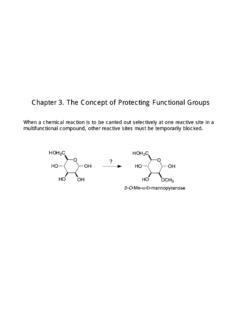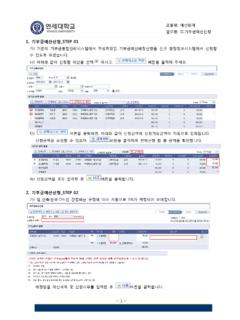Transcription of Ch. 13 Fundamentals of Electrochemistry - Yonsei …
1 Ch. 13 fundamentals of electrochemistry 13-1. Basic Concepts of Electrochemistry redox reaction : reactions with electron transfer oxidized : loses electrons reduced : gains electrons Fe3+ + V2+ Fe2+ + V3+. oxidizing agent (oxidant) : takes electrons from others and reduces reducing agent (reductant) : oxidizes itself 1. Electric charge (q). q : [coulomb] or [C] = x 10-19 C for a single electron for 1 mole of e x 10-19 C x /mol q = n F C/mol Faraday constant [F]. 13:20 Anal. Chem. by Prof. Myeong Hee Moon 13-1. Basic Concepts of Electrochemistry ex) If g of Fe2+ was reduced in the reaction above, how many coulombs of charge must have been transferred from V2+ to Fe3+ ?
2 13:20 Anal. Chem. by Prof. Myeong Hee Moon 13-1. Basic Concepts of Electrochemistry 2. Electric Current : quantity of charge per second [A], ampere <a charge of one coulomb per second>. ex) Suppose that electrons are forced into a platinum wire immersed in a solution containing Sn4+, which is reduced to Sn2+ at a constant rate of mmol/h. How much current flows into the solution ? C/s = 13:20 Anal. Chem. by Prof. Myeong Hee Moon 13-1. Basic Concepts of Electrochemistry 3. voltage, work, free energy difference in electrical potential (E) between two points = potential difference [V], volts work : energy in joules [J].
3 J = E q one joule of energy = one coulomb of charge is moved between points whose potential differ by one volt. Ex) How much work is required to move mmol of electrons through a potential difference of V ? J. 13:20 Anal. Chem. by Prof. Myeong Hee Moon 13-1. Basic Concepts of Electrochemistry The free energy change : G. work done on surrounding : - G. G = -E q = - n F E. 4) Ohm's law current, I, flowing through a circuit E. I [ ]. R. 13:20 Anal. Chem. by Prof. Myeong Hee Moon 13-1. Basic Concepts of Electrochemistry 5) power : p work done per unit time, J/s or watt work Eq q p E. s s s EI. 13:20 Anal. Chem.
4 By Prof. Myeong Hee Moon 13-1. Basic Concepts of Electrochemistry Type of Electrochemical cells Galvanic Cells : A cell generates electric energy from where ? chemical reaction. = spontaneous reaction Electrolytic Cells : requires an external source of one reagent must be oxidized, the other reduced. 13:20 Anal. Chem. by Prof. Myeong Hee Moon 13-2. A galvanic cell in Action reduction : 2 AgCl (s) + 2 e- 2 Ag(s) + 2 Cl- (aq). oxidation : Cd(s) Cd2+ (aq) + 2 e- Net Cd(s) +2 AgCl (s) Cd2+ (aq) + 2 Cl- (aq). + Ag(s). G = -150 KJ/mol of Cd 13:20 Anal. Chem. by Prof. Myeong Hee Moon 13-2. A galvanic cell in Action KCl contained gel agar with KCl 2.
5 Salt Bridge cathode: 2 Ag+ (aq) + 2 e- 2 Ag(s) 3) Line notation anode : Cd (s) Cd2+ (aq) + 2 e- | phase boundary || salt bridge net : Cd(s) + 2 Ag+(aq) Cd2+ + 2 Ag(s). Cd(s) | Cd(NO3)2 (aq) || AgNO3 (aq) | Ag (s). 13:20 Anal. Chem. by Prof. Myeong Hee Moon 13-3. Standard Potentials measured voltage potential difference between Ag and Cd electrodes - Positive voltage when e- flows from anode into neg terminal. - Opposite connection : negative - standard reduction potential (Eo). : activities of all species are unity - left half cell :standard hydrogen electrode(SHE). if PH2(g) is 1 atm, EH 0, definition 2 ,H.
6 By convention, it is written as SHE || Ag+ | Ag(s). 13:20 Anal. Chem. by Prof. Myeong Hee Moon 13-3. Standard Potentials Standard Reduction Potentials std. Reduction potential = potential difference between the std potential of the reduction of interest and the potential of SHE. positive: electrons move from SHE to Ag+. negative: electrons moves reverse direction 13:20 Anal. Chem. by Prof. Myeong Hee Moon 13-4. Nernst eq : net driving force 1) Nernst eq. for a half reaction, a A + n e- b B. RT ABb E0 : potential E E 0. log a R: gas constant J/mol-K. nF AA. n: number of moles It shows two terms. 1. driving force under std.
7 Condition = E0. 2. concentration dependence (activity term). concentration term in Nernst Eq. ABa reaction quotient a Q pure solids, pure liquids, solvent not included AA. ABb E E 0. log a At 250 C Nernst equation simplifies to n AA. change per 10 fold change 13:20 Anal. Chem. by Prof. Myeong Hee Moon 13-4. Nernst eq : net driving force 2) Nernst equation for a complete reaction voltage difference (E) for the two electrodes. E = E+ - E- E+ : potential of electrode at positive input terminal of potentiometer = Ecathode Procedure: 1. write half reactions with 2. write Nernst equation for half reaction 3. The more positive E0 reduction predominantly happen 4.
8 Calculate net cell voltage E = E+ - E- 5. write balanced reaction by subtracting the half reaction 13:20 Anal. Chem. by Prof. Myeong Hee Moon 13-4. Nernst eq : net driving force ex) Find the voltage of the cell in Figure 14-5 if the right half cell contains M. AgNO3 (aq) and the left half cell contains M CdCl2 (aq). Write the net cell reaction and state whether it is spontaneous in the forward or reverse direction. right: 2 Ag+ (aq) + 2 e- 2 Ag(s) left: Cd2+ (aq) + 2 e- Cd (s) net : Cd(s) + 2 Ag+(aq) Cd2+ + 2 Ag(s). E+ = , E-= , E = E+-E- = 13:20 Anal. Chem. by Prof. Myeong Hee Moon 13-4. Nernst eq : net driving force * Advice for finding relevant half-cell reactions Pb(s) | PbF2 (s) | F- (aq) || Cu+2 (aq) | Cu(s).
9 Anode cathode oxidation reduction right : Cu2+ + 2 e Cu (s). left: PbF2 (s) + 2 e 2 F- + Pb (s). in fact, 2 F- + Pb (s) PbF2 (s) + 2 e 13:20 Anal. Chem. by Prof. Myeong Hee Moon 13-5. E0 and the equilibrium constant E0 and the equilibrium constant : galvanic cell produces electricity until the cell reaches eq. At eq. E=0. right electrode : a A + n e- c C E+0. left electrode : d D + n e - b B E-0. Ac Ab . E E E (E 0 E 0 ) log Ca log Bd . n AA AD . Ac Ad . E0 log{ Ca Db } Q : reaction quotient n AA AB . at eq. E=0 as Q=K E0 = log k (at 250C). n nE 0. K = 10. 13:20 Anal. Chem. by Prof. Myeong Hee Moon 13-6. Cells as chemical probes right half cell : AgCl(s) Ag+ (aq) + Cl-(aq).
10 Left half cell : CH3 COOH CH3 COO- (aq) + H+(aq). they come to equilibrium without other half-cell --- chemical reaction 13:20 Anal. Chem. by Prof. Myeong Hee Moon 13-6. Cells as chemical probes with cell assembled, AgCl(s) + e- Ag (s) + Cl-(aq, ) E+0 = in left : the only element -- hydrogen gas bubbles out 2 H+(aq, ?M) + 2 e- H2 (g, ) E-0 = 0. E = E+ - E- P. = ( log[Cl-]2) - (0- log H 2 ). 2. 2 2 [H ]. in order to have same electrons we know [Cl-], adjustedPH = 1. 2. [H ]2 [Cl ]2. = - log = V. PH 2 Thus, [H+] = x 10-4 M. we can calculate K for this case (Ka). Ka = =. cell probe to measure the unknown H+ conc.







![[2018학년도 1학기 캡스톤디자인 교과목 수강안내]](/cache/preview/3/e/4/9/a/1/1/8/thumb-3e49a11816b00a41d9e0e5395cc6c996.jpg)